Health Intervention Program Report: Depression in Working Population
VerifiedAdded on 2022/02/26
|14
|3785
|15
Report
AI Summary
This report presents a health intervention program aimed at addressing depression and substance abuse within the Ikate community in Lagos, Nigeria. It highlights the impact of depression, particularly among the working population, and identifies drug and alcohol use as a key health behavior. The report explores counseling as a therapeutic approach and discusses the benefits of motivational interviewing and the Rational Emotive Behavioral Therapy (REBT) as intervention techniques. It analyzes the advantages and disadvantages of these methods, considering factors like healthcare outcomes, costs, and implementation challenges. The report concludes with a recommendation to integrate the REBT approach into counseling programs within the community, emphasizing the importance of mental health intervention and the need for further research and program evaluation to reduce the prevalence of depression.
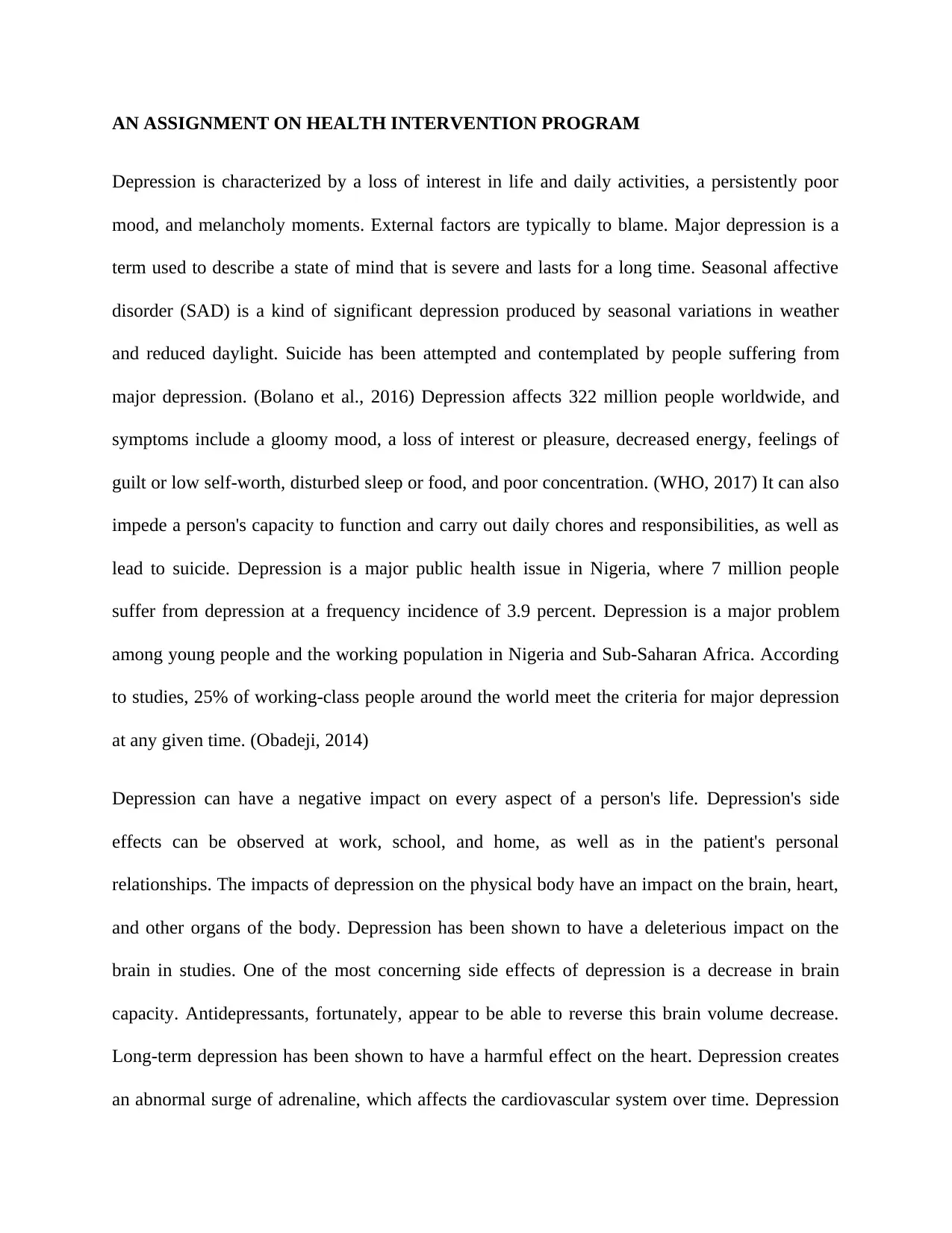
AN ASSIGNMENT ON HEALTH INTERVENTION PROGRAM
Depression is characterized by a loss of interest in life and daily activities, a persistently poor
mood, and melancholy moments. External factors are typically to blame. Major depression is a
term used to describe a state of mind that is severe and lasts for a long time. Seasonal affective
disorder (SAD) is a kind of significant depression produced by seasonal variations in weather
and reduced daylight. Suicide has been attempted and contemplated by people suffering from
major depression. (Bolano et al., 2016) Depression affects 322 million people worldwide, and
symptoms include a gloomy mood, a loss of interest or pleasure, decreased energy, feelings of
guilt or low self-worth, disturbed sleep or food, and poor concentration. (WHO, 2017) It can also
impede a person's capacity to function and carry out daily chores and responsibilities, as well as
lead to suicide. Depression is a major public health issue in Nigeria, where 7 million people
suffer from depression at a frequency incidence of 3.9 percent. Depression is a major problem
among young people and the working population in Nigeria and Sub-Saharan Africa. According
to studies, 25% of working-class people around the world meet the criteria for major depression
at any given time. (Obadeji, 2014)
Depression can have a negative impact on every aspect of a person's life. Depression's side
effects can be observed at work, school, and home, as well as in the patient's personal
relationships. The impacts of depression on the physical body have an impact on the brain, heart,
and other organs of the body. Depression has been shown to have a deleterious impact on the
brain in studies. One of the most concerning side effects of depression is a decrease in brain
capacity. Antidepressants, fortunately, appear to be able to reverse this brain volume decrease.
Long-term depression has been shown to have a harmful effect on the heart. Depression creates
an abnormal surge of adrenaline, which affects the cardiovascular system over time. Depression
Depression is characterized by a loss of interest in life and daily activities, a persistently poor
mood, and melancholy moments. External factors are typically to blame. Major depression is a
term used to describe a state of mind that is severe and lasts for a long time. Seasonal affective
disorder (SAD) is a kind of significant depression produced by seasonal variations in weather
and reduced daylight. Suicide has been attempted and contemplated by people suffering from
major depression. (Bolano et al., 2016) Depression affects 322 million people worldwide, and
symptoms include a gloomy mood, a loss of interest or pleasure, decreased energy, feelings of
guilt or low self-worth, disturbed sleep or food, and poor concentration. (WHO, 2017) It can also
impede a person's capacity to function and carry out daily chores and responsibilities, as well as
lead to suicide. Depression is a major public health issue in Nigeria, where 7 million people
suffer from depression at a frequency incidence of 3.9 percent. Depression is a major problem
among young people and the working population in Nigeria and Sub-Saharan Africa. According
to studies, 25% of working-class people around the world meet the criteria for major depression
at any given time. (Obadeji, 2014)
Depression can have a negative impact on every aspect of a person's life. Depression's side
effects can be observed at work, school, and home, as well as in the patient's personal
relationships. The impacts of depression on the physical body have an impact on the brain, heart,
and other organs of the body. Depression has been shown to have a deleterious impact on the
brain in studies. One of the most concerning side effects of depression is a decrease in brain
capacity. Antidepressants, fortunately, appear to be able to reverse this brain volume decrease.
Long-term depression has been shown to have a harmful effect on the heart. Depression creates
an abnormal surge of adrenaline, which affects the cardiovascular system over time. Depression
Paraphrase This Document
Need a fresh take? Get an instant paraphrase of this document with our AI Paraphraser
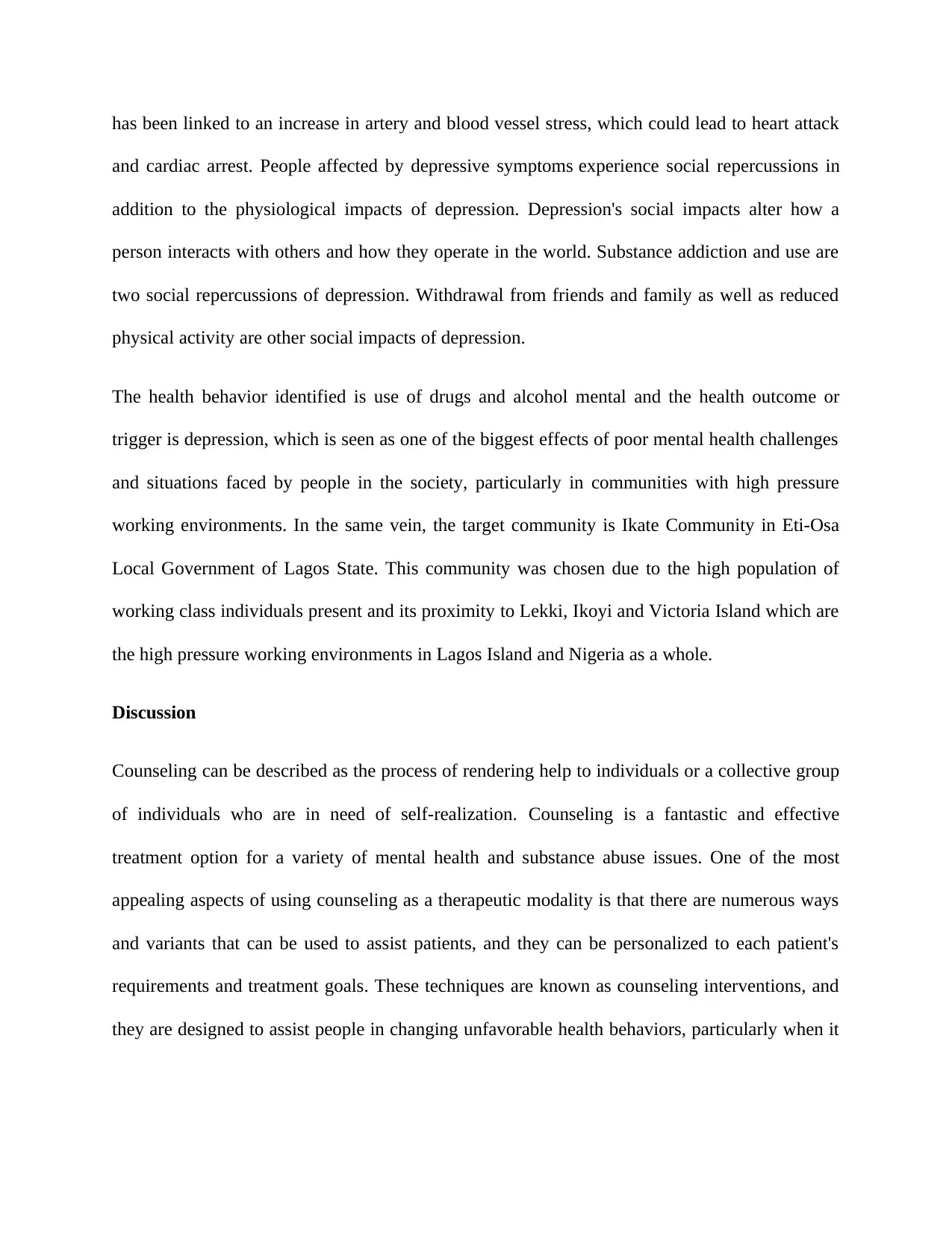
has been linked to an increase in artery and blood vessel stress, which could lead to heart attack
and cardiac arrest. People affected by depressive symptoms experience social repercussions in
addition to the physiological impacts of depression. Depression's social impacts alter how a
person interacts with others and how they operate in the world. Substance addiction and use are
two social repercussions of depression. Withdrawal from friends and family as well as reduced
physical activity are other social impacts of depression.
The health behavior identified is use of drugs and alcohol mental and the health outcome or
trigger is depression, which is seen as one of the biggest effects of poor mental health challenges
and situations faced by people in the society, particularly in communities with high pressure
working environments. In the same vein, the target community is Ikate Community in Eti-Osa
Local Government of Lagos State. This community was chosen due to the high population of
working class individuals present and its proximity to Lekki, Ikoyi and Victoria Island which are
the high pressure working environments in Lagos Island and Nigeria as a whole.
Discussion
Counseling can be described as the process of rendering help to individuals or a collective group
of individuals who are in need of self-realization. Counseling is a fantastic and effective
treatment option for a variety of mental health and substance abuse issues. One of the most
appealing aspects of using counseling as a therapeutic modality is that there are numerous ways
and variants that can be used to assist patients, and they can be personalized to each patient's
requirements and treatment goals. These techniques are known as counseling interventions, and
they are designed to assist people in changing unfavorable health behaviors, particularly when it
and cardiac arrest. People affected by depressive symptoms experience social repercussions in
addition to the physiological impacts of depression. Depression's social impacts alter how a
person interacts with others and how they operate in the world. Substance addiction and use are
two social repercussions of depression. Withdrawal from friends and family as well as reduced
physical activity are other social impacts of depression.
The health behavior identified is use of drugs and alcohol mental and the health outcome or
trigger is depression, which is seen as one of the biggest effects of poor mental health challenges
and situations faced by people in the society, particularly in communities with high pressure
working environments. In the same vein, the target community is Ikate Community in Eti-Osa
Local Government of Lagos State. This community was chosen due to the high population of
working class individuals present and its proximity to Lekki, Ikoyi and Victoria Island which are
the high pressure working environments in Lagos Island and Nigeria as a whole.
Discussion
Counseling can be described as the process of rendering help to individuals or a collective group
of individuals who are in need of self-realization. Counseling is a fantastic and effective
treatment option for a variety of mental health and substance abuse issues. One of the most
appealing aspects of using counseling as a therapeutic modality is that there are numerous ways
and variants that can be used to assist patients, and they can be personalized to each patient's
requirements and treatment goals. These techniques are known as counseling interventions, and
they are designed to assist people in changing unfavorable health behaviors, particularly when it
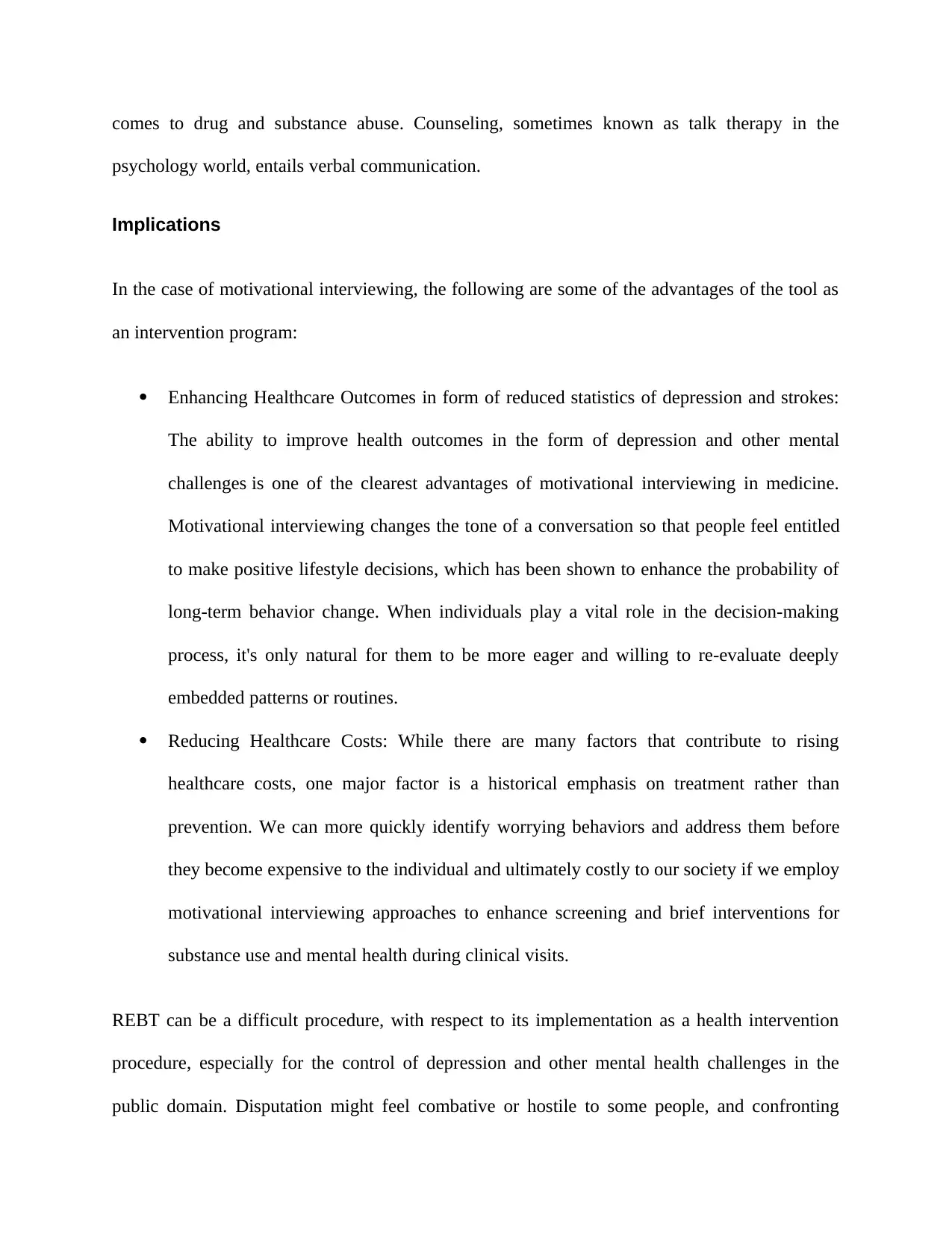
comes to drug and substance abuse. Counseling, sometimes known as talk therapy in the
psychology world, entails verbal communication.
Implications
In the case of motivational interviewing, the following are some of the advantages of the tool as
an intervention program:
Enhancing Healthcare Outcomes in form of reduced statistics of depression and strokes:
The ability to improve health outcomes in the form of depression and other mental
challenges is one of the clearest advantages of motivational interviewing in medicine.
Motivational interviewing changes the tone of a conversation so that people feel entitled
to make positive lifestyle decisions, which has been shown to enhance the probability of
long-term behavior change. When individuals play a vital role in the decision-making
process, it's only natural for them to be more eager and willing to re-evaluate deeply
embedded patterns or routines.
Reducing Healthcare Costs: While there are many factors that contribute to rising
healthcare costs, one major factor is a historical emphasis on treatment rather than
prevention. We can more quickly identify worrying behaviors and address them before
they become expensive to the individual and ultimately costly to our society if we employ
motivational interviewing approaches to enhance screening and brief interventions for
substance use and mental health during clinical visits.
REBT can be a difficult procedure, with respect to its implementation as a health intervention
procedure, especially for the control of depression and other mental health challenges in the
public domain. Disputation might feel combative or hostile to some people, and confronting
psychology world, entails verbal communication.
Implications
In the case of motivational interviewing, the following are some of the advantages of the tool as
an intervention program:
Enhancing Healthcare Outcomes in form of reduced statistics of depression and strokes:
The ability to improve health outcomes in the form of depression and other mental
challenges is one of the clearest advantages of motivational interviewing in medicine.
Motivational interviewing changes the tone of a conversation so that people feel entitled
to make positive lifestyle decisions, which has been shown to enhance the probability of
long-term behavior change. When individuals play a vital role in the decision-making
process, it's only natural for them to be more eager and willing to re-evaluate deeply
embedded patterns or routines.
Reducing Healthcare Costs: While there are many factors that contribute to rising
healthcare costs, one major factor is a historical emphasis on treatment rather than
prevention. We can more quickly identify worrying behaviors and address them before
they become expensive to the individual and ultimately costly to our society if we employ
motivational interviewing approaches to enhance screening and brief interventions for
substance use and mental health during clinical visits.
REBT can be a difficult procedure, with respect to its implementation as a health intervention
procedure, especially for the control of depression and other mental health challenges in the
public domain. Disputation might feel combative or hostile to some people, and confronting
⊘ This is a preview!⊘
Do you want full access?
Subscribe today to unlock all pages.

Trusted by 1+ million students worldwide
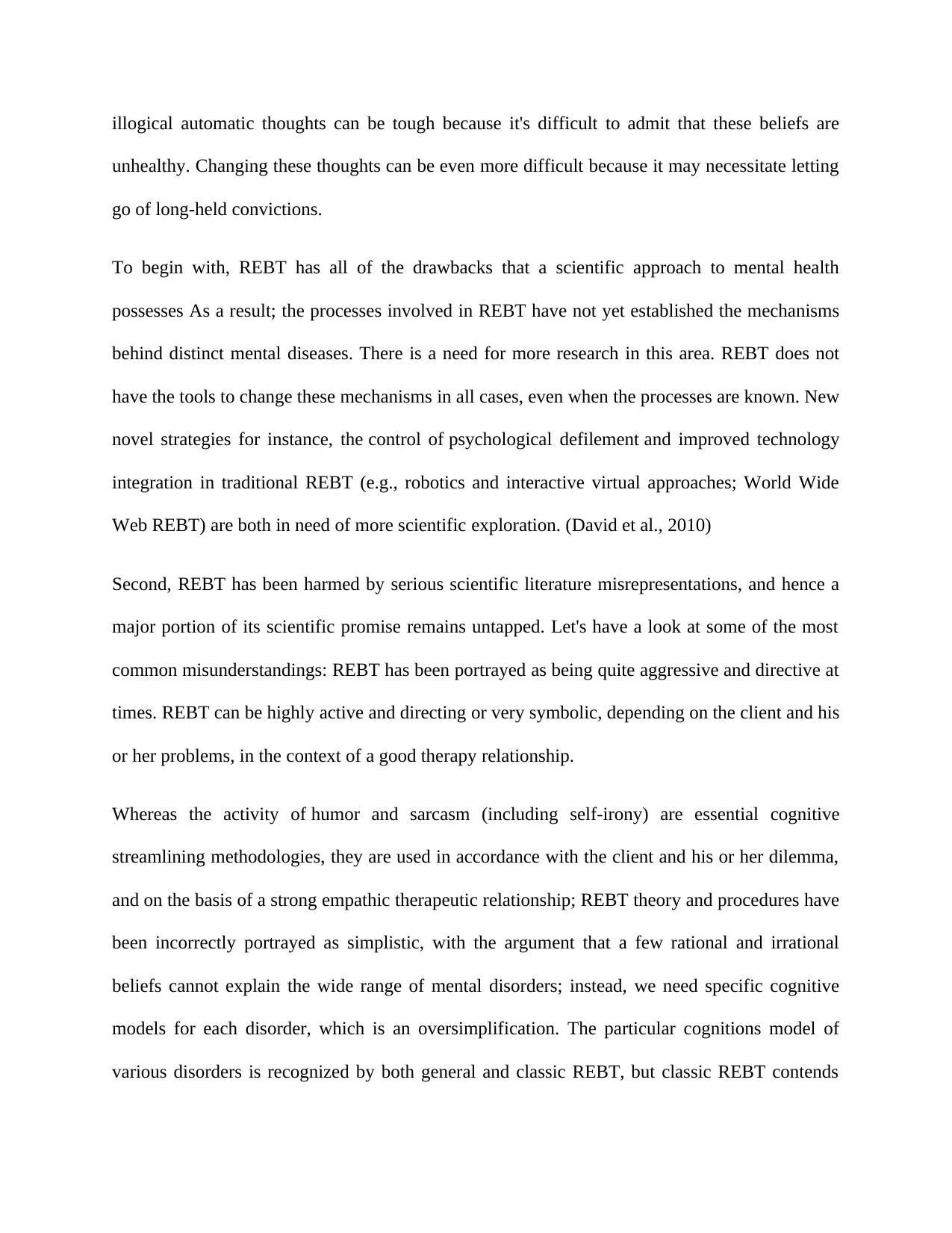
illogical automatic thoughts can be tough because it's difficult to admit that these beliefs are
unhealthy. Changing these thoughts can be even more difficult because it may necessitate letting
go of long-held convictions.
To begin with, REBT has all of the drawbacks that a scientific approach to mental health
possesses As a result; the processes involved in REBT have not yet established the mechanisms
behind distinct mental diseases. There is a need for more research in this area. REBT does not
have the tools to change these mechanisms in all cases, even when the processes are known. New
novel strategies for instance, the control of psychological defilement and improved technology
integration in traditional REBT (e.g., robotics and interactive virtual approaches; World Wide
Web REBT) are both in need of more scientific exploration. (David et al., 2010)
Second, REBT has been harmed by serious scientific literature misrepresentations, and hence a
major portion of its scientific promise remains untapped. Let's have a look at some of the most
common misunderstandings: REBT has been portrayed as being quite aggressive and directive at
times. REBT can be highly active and directing or very symbolic, depending on the client and his
or her problems, in the context of a good therapy relationship.
Whereas the activity of humor and sarcasm (including self-irony) are essential cognitive
streamlining methodologies, they are used in accordance with the client and his or her dilemma,
and on the basis of a strong empathic therapeutic relationship; REBT theory and procedures have
been incorrectly portrayed as simplistic, with the argument that a few rational and irrational
beliefs cannot explain the wide range of mental disorders; instead, we need specific cognitive
models for each disorder, which is an oversimplification. The particular cognitions model of
various disorders is recognized by both general and classic REBT, but classic REBT contends
unhealthy. Changing these thoughts can be even more difficult because it may necessitate letting
go of long-held convictions.
To begin with, REBT has all of the drawbacks that a scientific approach to mental health
possesses As a result; the processes involved in REBT have not yet established the mechanisms
behind distinct mental diseases. There is a need for more research in this area. REBT does not
have the tools to change these mechanisms in all cases, even when the processes are known. New
novel strategies for instance, the control of psychological defilement and improved technology
integration in traditional REBT (e.g., robotics and interactive virtual approaches; World Wide
Web REBT) are both in need of more scientific exploration. (David et al., 2010)
Second, REBT has been harmed by serious scientific literature misrepresentations, and hence a
major portion of its scientific promise remains untapped. Let's have a look at some of the most
common misunderstandings: REBT has been portrayed as being quite aggressive and directive at
times. REBT can be highly active and directing or very symbolic, depending on the client and his
or her problems, in the context of a good therapy relationship.
Whereas the activity of humor and sarcasm (including self-irony) are essential cognitive
streamlining methodologies, they are used in accordance with the client and his or her dilemma,
and on the basis of a strong empathic therapeutic relationship; REBT theory and procedures have
been incorrectly portrayed as simplistic, with the argument that a few rational and irrational
beliefs cannot explain the wide range of mental disorders; instead, we need specific cognitive
models for each disorder, which is an oversimplification. The particular cognitions model of
various disorders is recognized by both general and classic REBT, but classic REBT contends
Paraphrase This Document
Need a fresh take? Get an instant paraphrase of this document with our AI Paraphraser
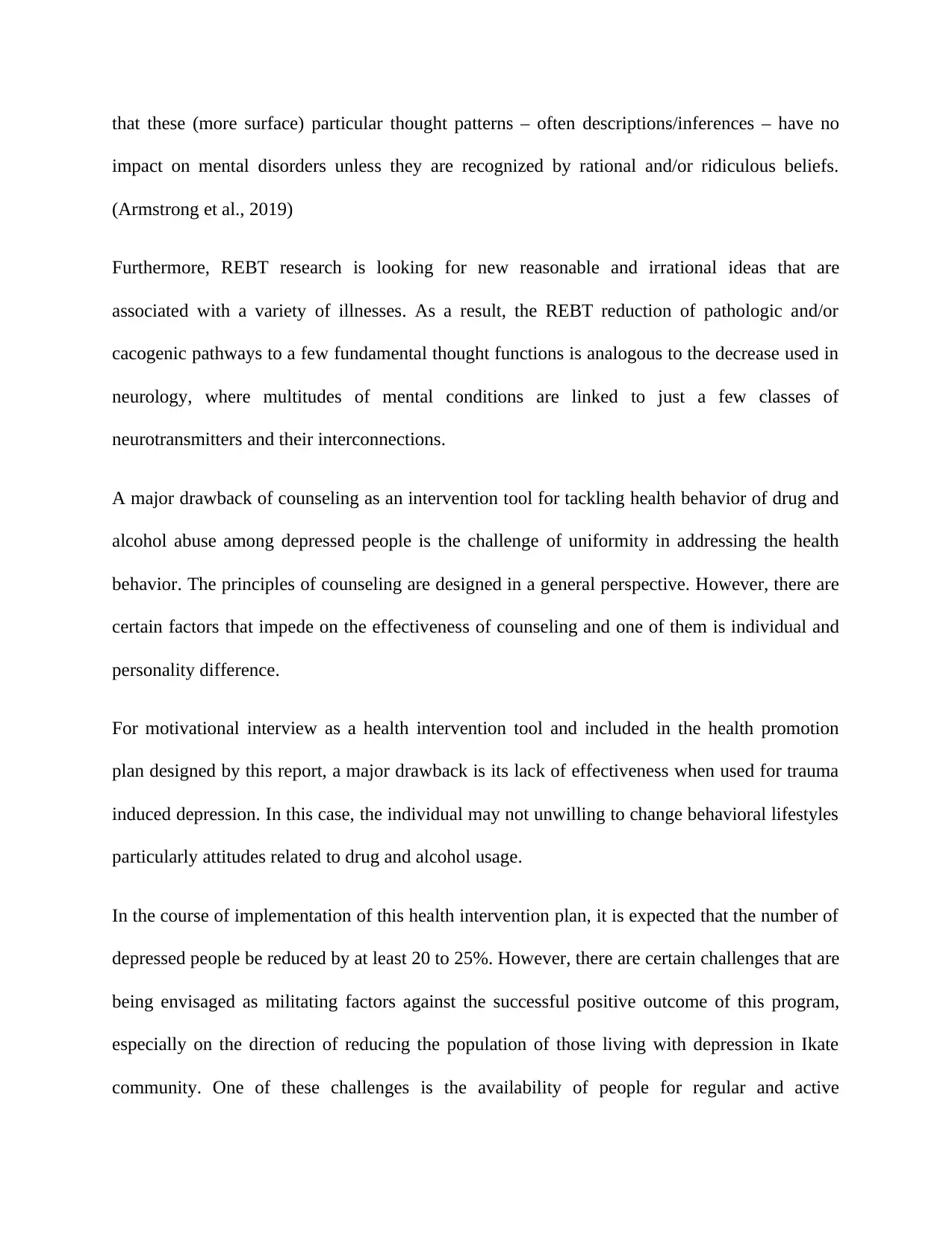
that these (more surface) particular thought patterns – often descriptions/inferences – have no
impact on mental disorders unless they are recognized by rational and/or ridiculous beliefs.
(Armstrong et al., 2019)
Furthermore, REBT research is looking for new reasonable and irrational ideas that are
associated with a variety of illnesses. As a result, the REBT reduction of pathologic and/or
cacogenic pathways to a few fundamental thought functions is analogous to the decrease used in
neurology, where multitudes of mental conditions are linked to just a few classes of
neurotransmitters and their interconnections.
A major drawback of counseling as an intervention tool for tackling health behavior of drug and
alcohol abuse among depressed people is the challenge of uniformity in addressing the health
behavior. The principles of counseling are designed in a general perspective. However, there are
certain factors that impede on the effectiveness of counseling and one of them is individual and
personality difference.
For motivational interview as a health intervention tool and included in the health promotion
plan designed by this report, a major drawback is its lack of effectiveness when used for trauma
induced depression. In this case, the individual may not unwilling to change behavioral lifestyles
particularly attitudes related to drug and alcohol usage.
In the course of implementation of this health intervention plan, it is expected that the number of
depressed people be reduced by at least 20 to 25%. However, there are certain challenges that are
being envisaged as militating factors against the successful positive outcome of this program,
especially on the direction of reducing the population of those living with depression in Ikate
community. One of these challenges is the availability of people for regular and active
impact on mental disorders unless they are recognized by rational and/or ridiculous beliefs.
(Armstrong et al., 2019)
Furthermore, REBT research is looking for new reasonable and irrational ideas that are
associated with a variety of illnesses. As a result, the REBT reduction of pathologic and/or
cacogenic pathways to a few fundamental thought functions is analogous to the decrease used in
neurology, where multitudes of mental conditions are linked to just a few classes of
neurotransmitters and their interconnections.
A major drawback of counseling as an intervention tool for tackling health behavior of drug and
alcohol abuse among depressed people is the challenge of uniformity in addressing the health
behavior. The principles of counseling are designed in a general perspective. However, there are
certain factors that impede on the effectiveness of counseling and one of them is individual and
personality difference.
For motivational interview as a health intervention tool and included in the health promotion
plan designed by this report, a major drawback is its lack of effectiveness when used for trauma
induced depression. In this case, the individual may not unwilling to change behavioral lifestyles
particularly attitudes related to drug and alcohol usage.
In the course of implementation of this health intervention plan, it is expected that the number of
depressed people be reduced by at least 20 to 25%. However, there are certain challenges that are
being envisaged as militating factors against the successful positive outcome of this program,
especially on the direction of reducing the population of those living with depression in Ikate
community. One of these challenges is the availability of people for regular and active
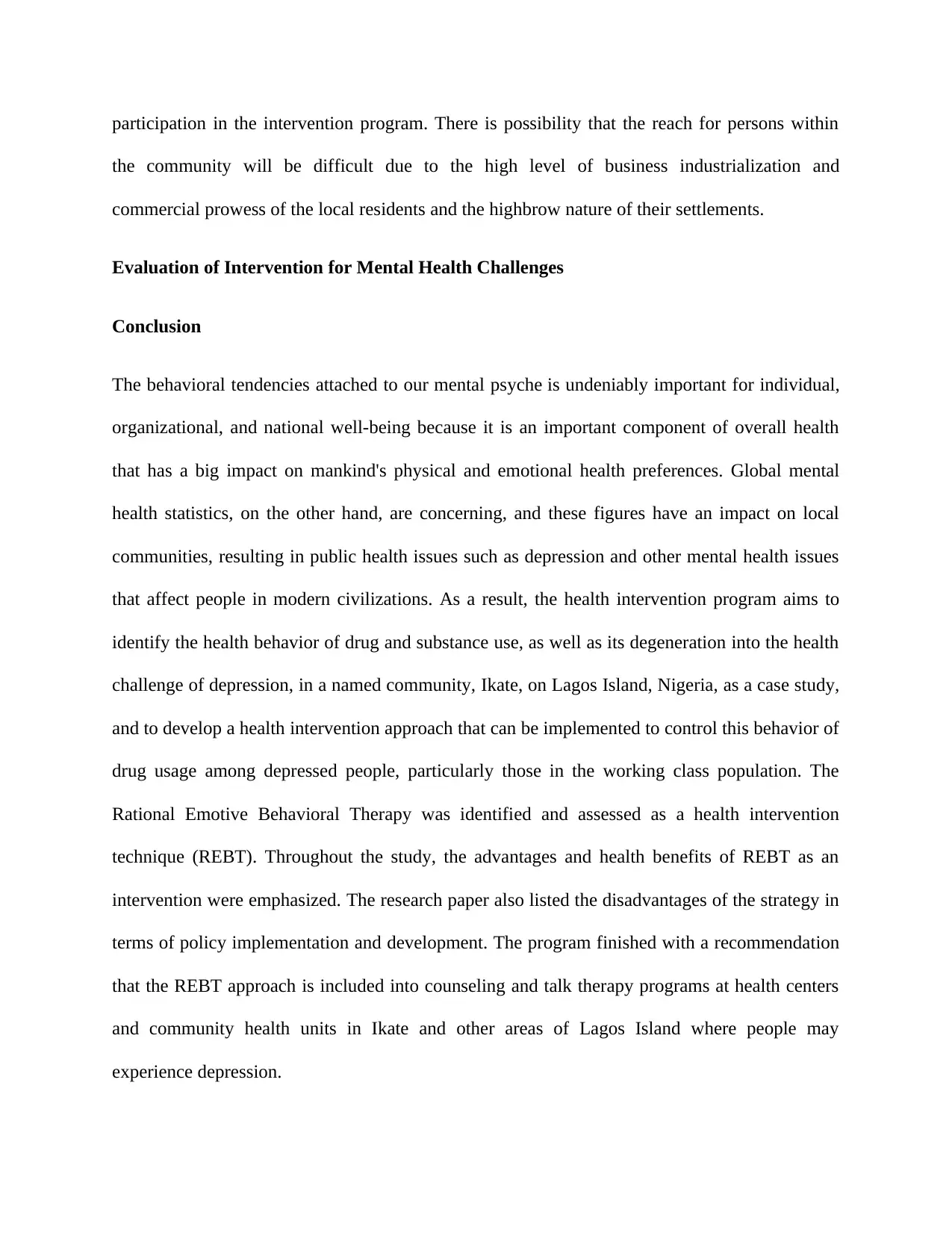
participation in the intervention program. There is possibility that the reach for persons within
the community will be difficult due to the high level of business industrialization and
commercial prowess of the local residents and the highbrow nature of their settlements.
Evaluation of Intervention for Mental Health Challenges
Conclusion
The behavioral tendencies attached to our mental psyche is undeniably important for individual,
organizational, and national well-being because it is an important component of overall health
that has a big impact on mankind's physical and emotional health preferences. Global mental
health statistics, on the other hand, are concerning, and these figures have an impact on local
communities, resulting in public health issues such as depression and other mental health issues
that affect people in modern civilizations. As a result, the health intervention program aims to
identify the health behavior of drug and substance use, as well as its degeneration into the health
challenge of depression, in a named community, Ikate, on Lagos Island, Nigeria, as a case study,
and to develop a health intervention approach that can be implemented to control this behavior of
drug usage among depressed people, particularly those in the working class population. The
Rational Emotive Behavioral Therapy was identified and assessed as a health intervention
technique (REBT). Throughout the study, the advantages and health benefits of REBT as an
intervention were emphasized. The research paper also listed the disadvantages of the strategy in
terms of policy implementation and development. The program finished with a recommendation
that the REBT approach is included into counseling and talk therapy programs at health centers
and community health units in Ikate and other areas of Lagos Island where people may
experience depression.
the community will be difficult due to the high level of business industrialization and
commercial prowess of the local residents and the highbrow nature of their settlements.
Evaluation of Intervention for Mental Health Challenges
Conclusion
The behavioral tendencies attached to our mental psyche is undeniably important for individual,
organizational, and national well-being because it is an important component of overall health
that has a big impact on mankind's physical and emotional health preferences. Global mental
health statistics, on the other hand, are concerning, and these figures have an impact on local
communities, resulting in public health issues such as depression and other mental health issues
that affect people in modern civilizations. As a result, the health intervention program aims to
identify the health behavior of drug and substance use, as well as its degeneration into the health
challenge of depression, in a named community, Ikate, on Lagos Island, Nigeria, as a case study,
and to develop a health intervention approach that can be implemented to control this behavior of
drug usage among depressed people, particularly those in the working class population. The
Rational Emotive Behavioral Therapy was identified and assessed as a health intervention
technique (REBT). Throughout the study, the advantages and health benefits of REBT as an
intervention were emphasized. The research paper also listed the disadvantages of the strategy in
terms of policy implementation and development. The program finished with a recommendation
that the REBT approach is included into counseling and talk therapy programs at health centers
and community health units in Ikate and other areas of Lagos Island where people may
experience depression.
⊘ This is a preview!⊘
Do you want full access?
Subscribe today to unlock all pages.

Trusted by 1+ million students worldwide
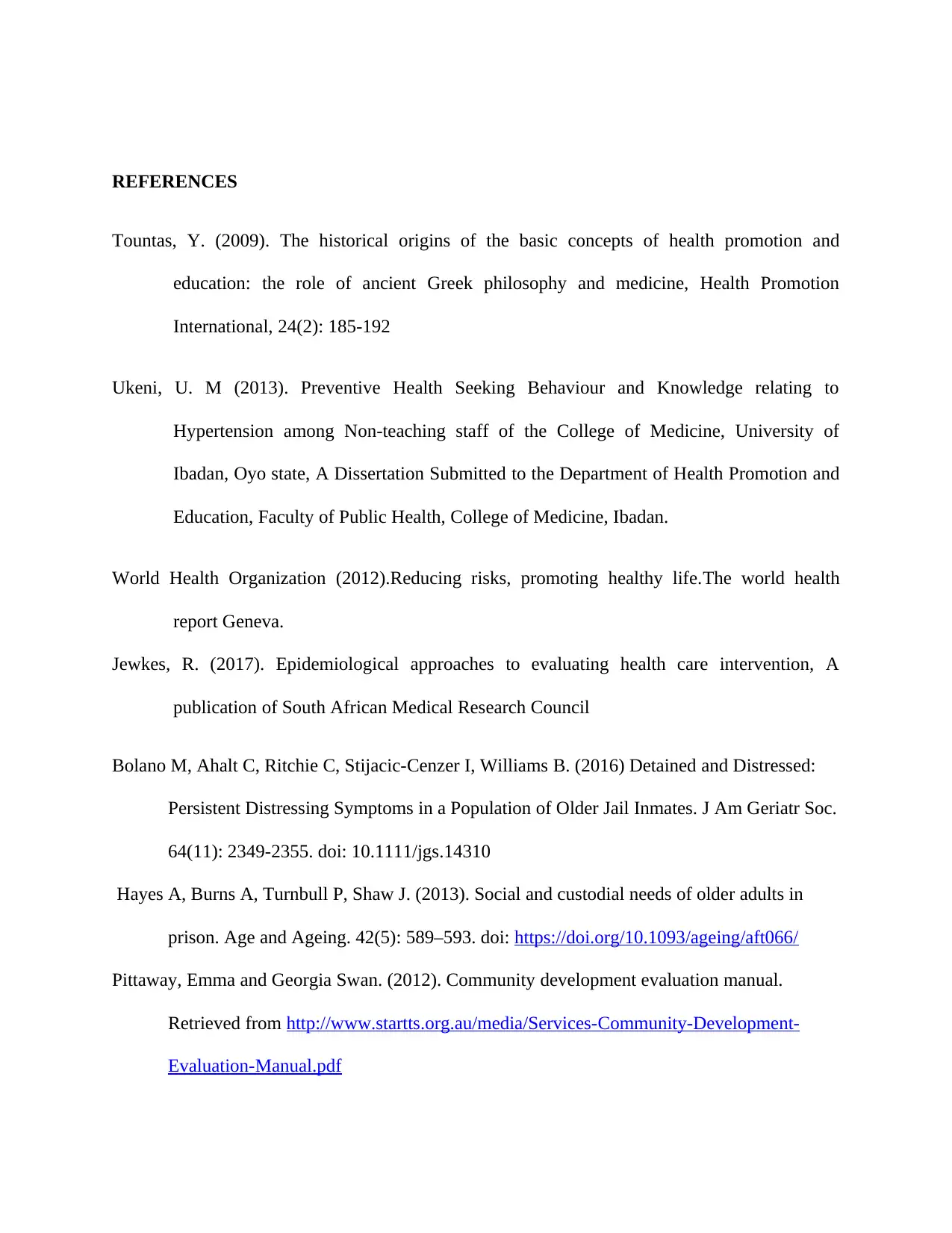
REFERENCES
Tountas, Y. (2009). The historical origins of the basic concepts of health promotion and
education: the role of ancient Greek philosophy and medicine, Health Promotion
International, 24(2): 185-192
Ukeni, U. M (2013). Preventive Health Seeking Behaviour and Knowledge relating to
Hypertension among Non-teaching staff of the College of Medicine, University of
Ibadan, Oyo state, A Dissertation Submitted to the Department of Health Promotion and
Education, Faculty of Public Health, College of Medicine, Ibadan.
World Health Organization (2012).Reducing risks, promoting healthy life.The world health
report Geneva.
Jewkes, R. (2017). Epidemiological approaches to evaluating health care intervention, A
publication of South African Medical Research Council
Bolano M, Ahalt C, Ritchie C, Stijacic-Cenzer I, Williams B. (2016) Detained and Distressed:
Persistent Distressing Symptoms in a Population of Older Jail Inmates. J Am Geriatr Soc.
64(11): 2349-2355. doi: 10.1111/jgs.14310
Hayes A, Burns A, Turnbull P, Shaw J. (2013). Social and custodial needs of older adults in
prison. Age and Ageing. 42(5): 589–593. doi: https://doi.org/10.1093/ageing/aft066/
Pittaway, Emma and Georgia Swan. (2012). Community development evaluation manual.
Retrieved from http://www.startts.org.au/media/Services-Community-Development-
Evaluation-Manual.pdf
Tountas, Y. (2009). The historical origins of the basic concepts of health promotion and
education: the role of ancient Greek philosophy and medicine, Health Promotion
International, 24(2): 185-192
Ukeni, U. M (2013). Preventive Health Seeking Behaviour and Knowledge relating to
Hypertension among Non-teaching staff of the College of Medicine, University of
Ibadan, Oyo state, A Dissertation Submitted to the Department of Health Promotion and
Education, Faculty of Public Health, College of Medicine, Ibadan.
World Health Organization (2012).Reducing risks, promoting healthy life.The world health
report Geneva.
Jewkes, R. (2017). Epidemiological approaches to evaluating health care intervention, A
publication of South African Medical Research Council
Bolano M, Ahalt C, Ritchie C, Stijacic-Cenzer I, Williams B. (2016) Detained and Distressed:
Persistent Distressing Symptoms in a Population of Older Jail Inmates. J Am Geriatr Soc.
64(11): 2349-2355. doi: 10.1111/jgs.14310
Hayes A, Burns A, Turnbull P, Shaw J. (2013). Social and custodial needs of older adults in
prison. Age and Ageing. 42(5): 589–593. doi: https://doi.org/10.1093/ageing/aft066/
Pittaway, Emma and Georgia Swan. (2012). Community development evaluation manual.
Retrieved from http://www.startts.org.au/media/Services-Community-Development-
Evaluation-Manual.pdf
Paraphrase This Document
Need a fresh take? Get an instant paraphrase of this document with our AI Paraphraser
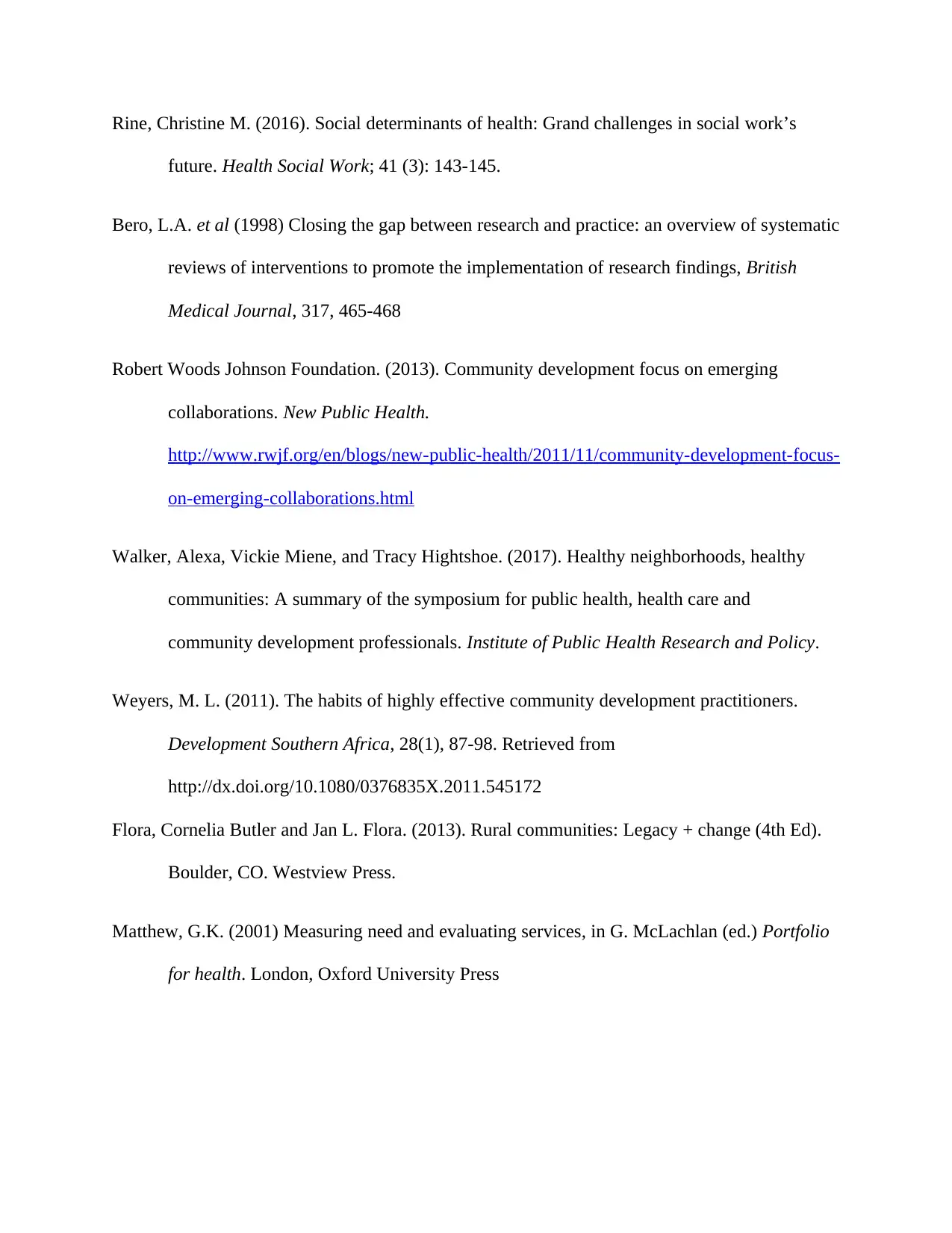
Rine, Christine M. (2016). Social determinants of health: Grand challenges in social work’s
future. Health Social Work; 41 (3): 143-145.
Bero, L.A. et al (1998) Closing the gap between research and practice: an overview of systematic
reviews of interventions to promote the implementation of research findings, British
Medical Journal, 317, 465-468
Robert Woods Johnson Foundation. (2013). Community development focus on emerging
collaborations. New Public Health.
http://www.rwjf.org/en/blogs/new-public-health/2011/11/community-development-focus-
on-emerging-collaborations.html
Walker, Alexa, Vickie Miene, and Tracy Hightshoe. (2017). Healthy neighborhoods, healthy
communities: A summary of the symposium for public health, health care and
community development professionals. Institute of Public Health Research and Policy.
Weyers, M. L. (2011). The habits of highly effective community development practitioners.
Development Southern Africa, 28(1), 87-98. Retrieved from
http://dx.doi.org/10.1080/0376835X.2011.545172
Flora, Cornelia Butler and Jan L. Flora. (2013). Rural communities: Legacy + change (4th Ed).
Boulder, CO. Westview Press.
Matthew, G.K. (2001) Measuring need and evaluating services, in G. McLachlan (ed.) Portfolio
for health. London, Oxford University Press
future. Health Social Work; 41 (3): 143-145.
Bero, L.A. et al (1998) Closing the gap between research and practice: an overview of systematic
reviews of interventions to promote the implementation of research findings, British
Medical Journal, 317, 465-468
Robert Woods Johnson Foundation. (2013). Community development focus on emerging
collaborations. New Public Health.
http://www.rwjf.org/en/blogs/new-public-health/2011/11/community-development-focus-
on-emerging-collaborations.html
Walker, Alexa, Vickie Miene, and Tracy Hightshoe. (2017). Healthy neighborhoods, healthy
communities: A summary of the symposium for public health, health care and
community development professionals. Institute of Public Health Research and Policy.
Weyers, M. L. (2011). The habits of highly effective community development practitioners.
Development Southern Africa, 28(1), 87-98. Retrieved from
http://dx.doi.org/10.1080/0376835X.2011.545172
Flora, Cornelia Butler and Jan L. Flora. (2013). Rural communities: Legacy + change (4th Ed).
Boulder, CO. Westview Press.
Matthew, G.K. (2001) Measuring need and evaluating services, in G. McLachlan (ed.) Portfolio
for health. London, Oxford University Press
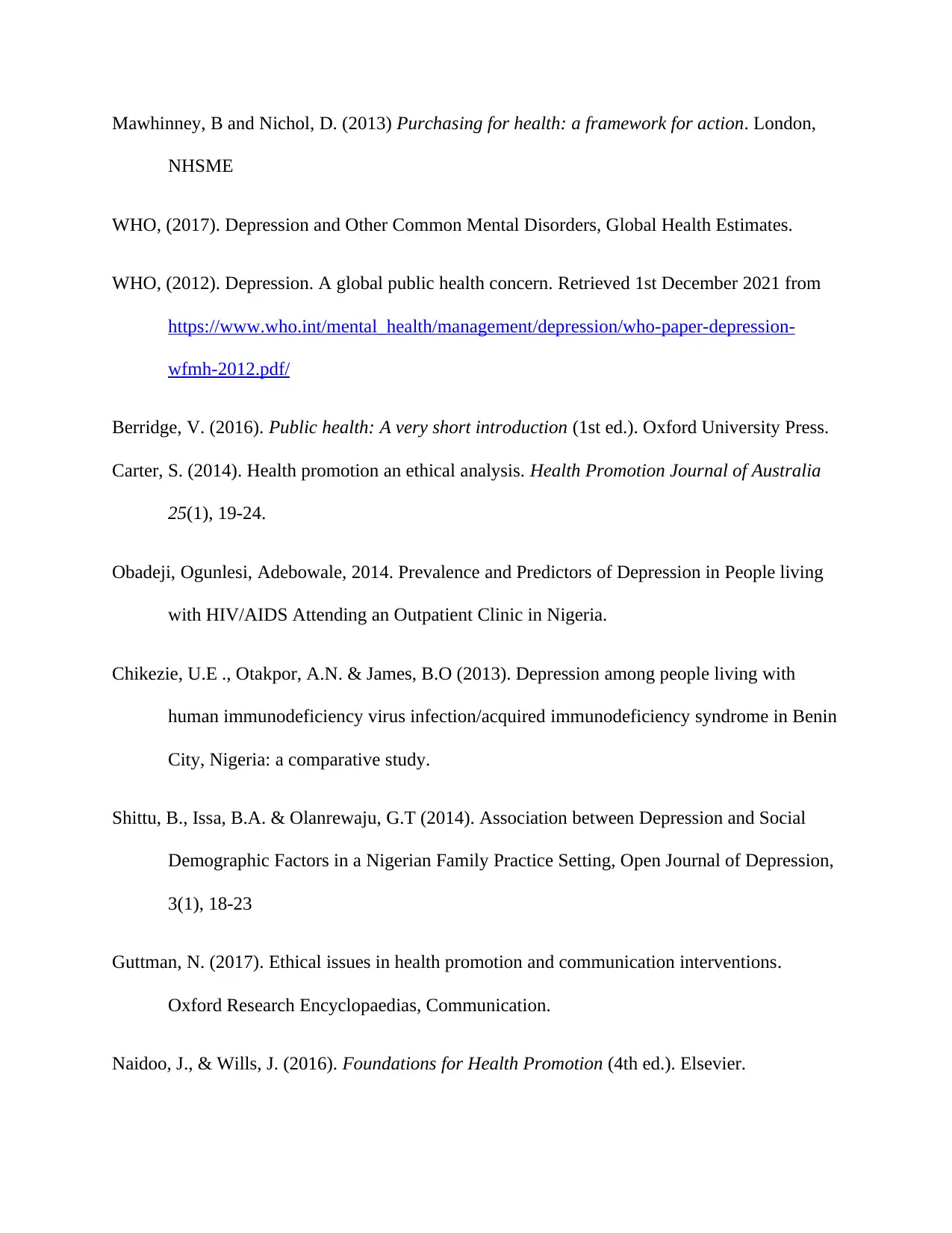
Mawhinney, B and Nichol, D. (2013) Purchasing for health: a framework for action. London,
NHSME
WHO, (2017). Depression and Other Common Mental Disorders, Global Health Estimates.
WHO, (2012). Depression. A global public health concern. Retrieved 1st December 2021 from
https://www.who.int/mental_health/management/depression/who-paper-depression-
wfmh-2012.pdf/
Berridge, V. (2016). Public health: A very short introduction (1st ed.). Oxford University Press.
Carter, S. (2014). Health promotion an ethical analysis. Health Promotion Journal of Australia
25(1), 19-24.
Obadeji, Ogunlesi, Adebowale, 2014. Prevalence and Predictors of Depression in People living
with HIV/AIDS Attending an Outpatient Clinic in Nigeria.
Chikezie, U.E ., Otakpor, A.N. & James, B.O (2013). Depression among people living with
human immunodeficiency virus infection/acquired immunodeficiency syndrome in Benin
City, Nigeria: a comparative study.
Shittu, B., Issa, B.A. & Olanrewaju, G.T (2014). Association between Depression and Social
Demographic Factors in a Nigerian Family Practice Setting, Open Journal of Depression,
3(1), 18-23
Guttman, N. (2017). Ethical issues in health promotion and communication interventions.
Oxford Research Encyclopaedias, Communication.
Naidoo, J., & Wills, J. (2016). Foundations for Health Promotion (4th ed.). Elsevier.
NHSME
WHO, (2017). Depression and Other Common Mental Disorders, Global Health Estimates.
WHO, (2012). Depression. A global public health concern. Retrieved 1st December 2021 from
https://www.who.int/mental_health/management/depression/who-paper-depression-
wfmh-2012.pdf/
Berridge, V. (2016). Public health: A very short introduction (1st ed.). Oxford University Press.
Carter, S. (2014). Health promotion an ethical analysis. Health Promotion Journal of Australia
25(1), 19-24.
Obadeji, Ogunlesi, Adebowale, 2014. Prevalence and Predictors of Depression in People living
with HIV/AIDS Attending an Outpatient Clinic in Nigeria.
Chikezie, U.E ., Otakpor, A.N. & James, B.O (2013). Depression among people living with
human immunodeficiency virus infection/acquired immunodeficiency syndrome in Benin
City, Nigeria: a comparative study.
Shittu, B., Issa, B.A. & Olanrewaju, G.T (2014). Association between Depression and Social
Demographic Factors in a Nigerian Family Practice Setting, Open Journal of Depression,
3(1), 18-23
Guttman, N. (2017). Ethical issues in health promotion and communication interventions.
Oxford Research Encyclopaedias, Communication.
Naidoo, J., & Wills, J. (2016). Foundations for Health Promotion (4th ed.). Elsevier.
⊘ This is a preview!⊘
Do you want full access?
Subscribe today to unlock all pages.

Trusted by 1+ million students worldwide
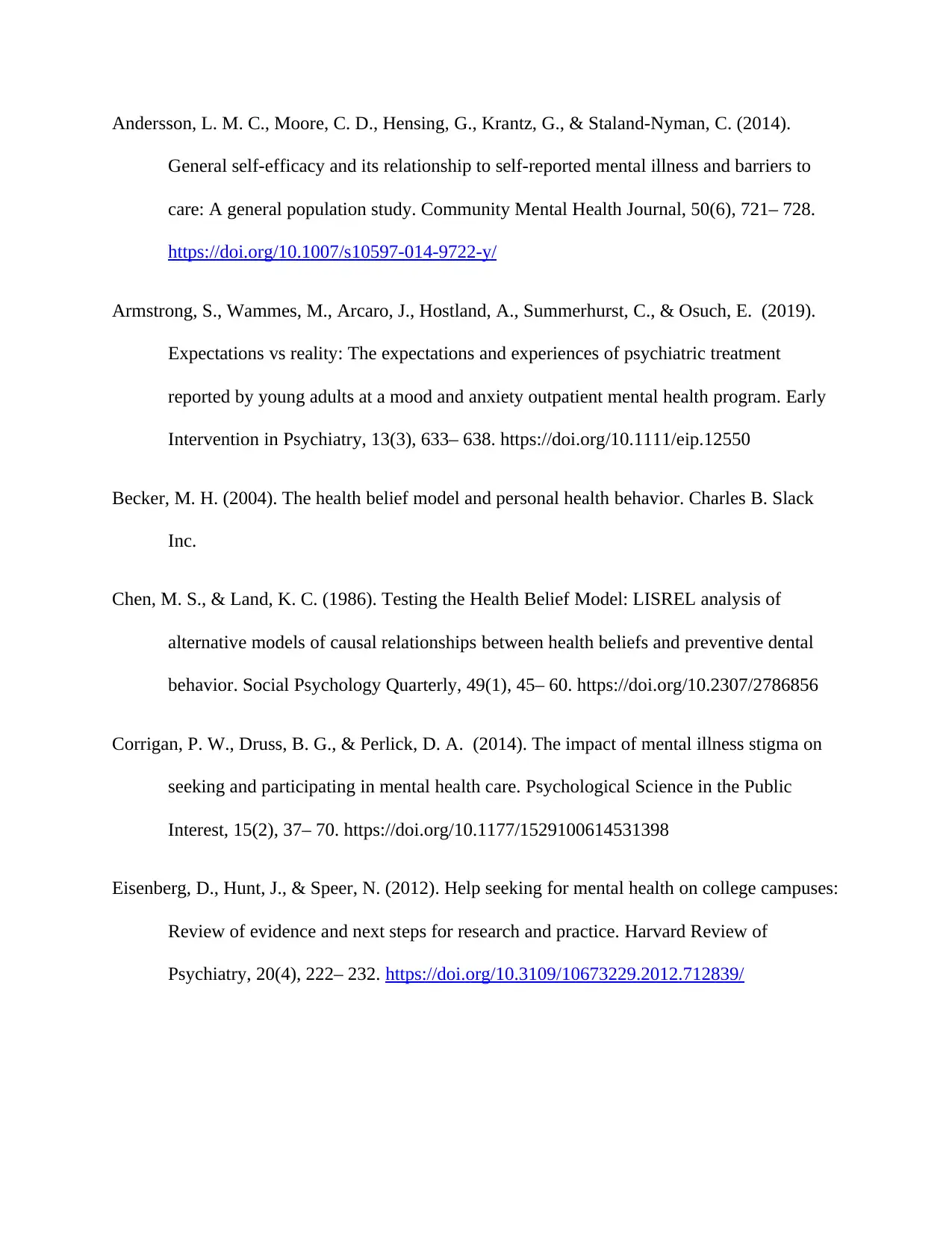
Andersson, L. M. C., Moore, C. D., Hensing, G., Krantz, G., & Staland-Nyman, C. (2014).
General self-efficacy and its relationship to self-reported mental illness and barriers to
care: A general population study. Community Mental Health Journal, 50(6), 721– 728.
https://doi.org/10.1007/s10597-014-9722-y/
Armstrong, S., Wammes, M., Arcaro, J., Hostland, A., Summerhurst, C., & Osuch, E. (2019).
Expectations vs reality: The expectations and experiences of psychiatric treatment
reported by young adults at a mood and anxiety outpatient mental health program. Early
Intervention in Psychiatry, 13(3), 633– 638. https://doi.org/10.1111/eip.12550
Becker, M. H. (2004). The health belief model and personal health behavior. Charles B. Slack
Inc.
Chen, M. S., & Land, K. C. (1986). Testing the Health Belief Model: LISREL analysis of
alternative models of causal relationships between health beliefs and preventive dental
behavior. Social Psychology Quarterly, 49(1), 45– 60. https://doi.org/10.2307/2786856
Corrigan, P. W., Druss, B. G., & Perlick, D. A. (2014). The impact of mental illness stigma on
seeking and participating in mental health care. Psychological Science in the Public
Interest, 15(2), 37– 70. https://doi.org/10.1177/1529100614531398
Eisenberg, D., Hunt, J., & Speer, N. (2012). Help seeking for mental health on college campuses:
Review of evidence and next steps for research and practice. Harvard Review of
Psychiatry, 20(4), 222– 232. https://doi.org/10.3109/10673229.2012.712839/
General self-efficacy and its relationship to self-reported mental illness and barriers to
care: A general population study. Community Mental Health Journal, 50(6), 721– 728.
https://doi.org/10.1007/s10597-014-9722-y/
Armstrong, S., Wammes, M., Arcaro, J., Hostland, A., Summerhurst, C., & Osuch, E. (2019).
Expectations vs reality: The expectations and experiences of psychiatric treatment
reported by young adults at a mood and anxiety outpatient mental health program. Early
Intervention in Psychiatry, 13(3), 633– 638. https://doi.org/10.1111/eip.12550
Becker, M. H. (2004). The health belief model and personal health behavior. Charles B. Slack
Inc.
Chen, M. S., & Land, K. C. (1986). Testing the Health Belief Model: LISREL analysis of
alternative models of causal relationships between health beliefs and preventive dental
behavior. Social Psychology Quarterly, 49(1), 45– 60. https://doi.org/10.2307/2786856
Corrigan, P. W., Druss, B. G., & Perlick, D. A. (2014). The impact of mental illness stigma on
seeking and participating in mental health care. Psychological Science in the Public
Interest, 15(2), 37– 70. https://doi.org/10.1177/1529100614531398
Eisenberg, D., Hunt, J., & Speer, N. (2012). Help seeking for mental health on college campuses:
Review of evidence and next steps for research and practice. Harvard Review of
Psychiatry, 20(4), 222– 232. https://doi.org/10.3109/10673229.2012.712839/
Paraphrase This Document
Need a fresh take? Get an instant paraphrase of this document with our AI Paraphraser
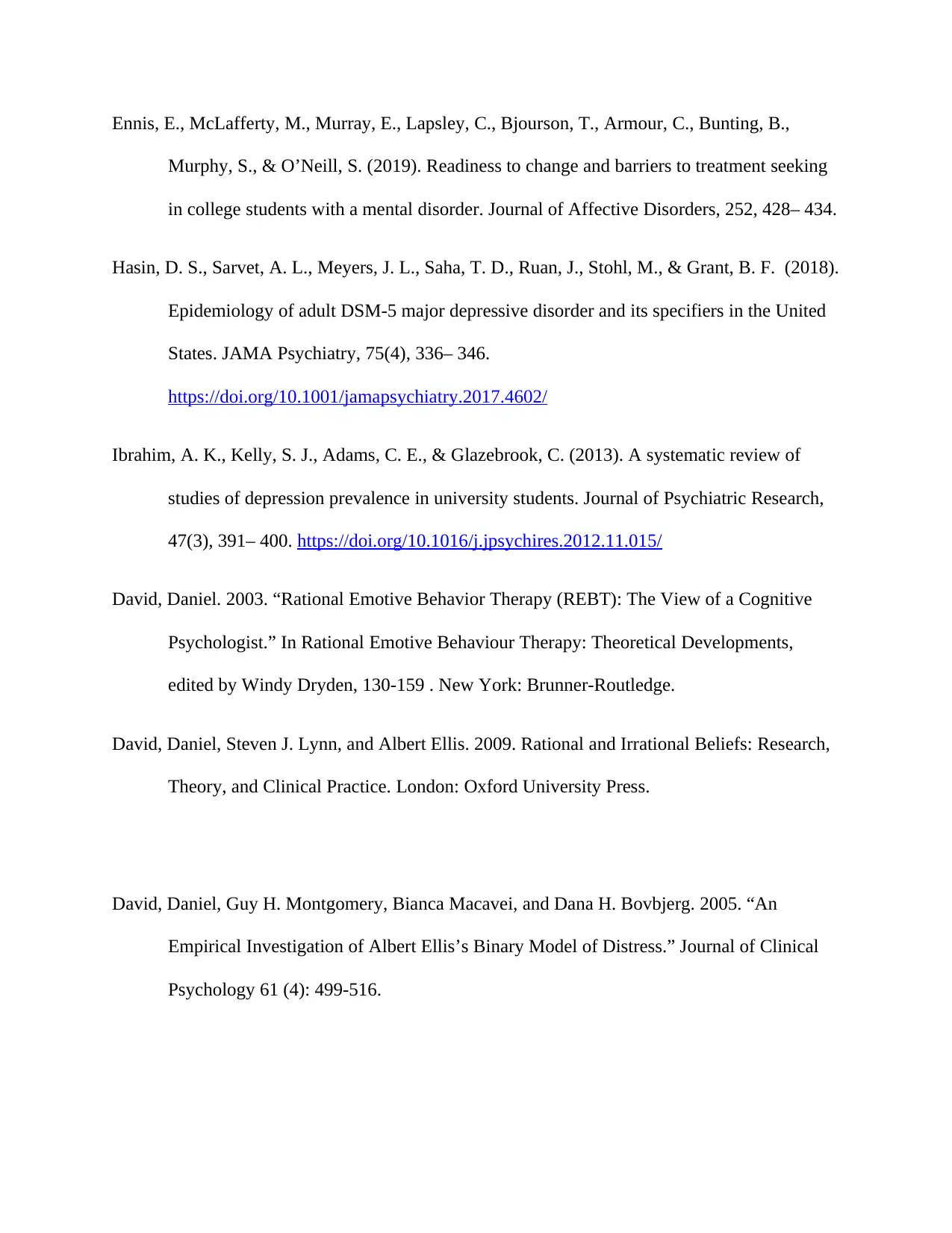
Ennis, E., McLafferty, M., Murray, E., Lapsley, C., Bjourson, T., Armour, C., Bunting, B.,
Murphy, S., & O’Neill, S. (2019). Readiness to change and barriers to treatment seeking
in college students with a mental disorder. Journal of Affective Disorders, 252, 428– 434.
Hasin, D. S., Sarvet, A. L., Meyers, J. L., Saha, T. D., Ruan, J., Stohl, M., & Grant, B. F. (2018).
Epidemiology of adult DSM-5 major depressive disorder and its specifiers in the United
States. JAMA Psychiatry, 75(4), 336– 346.
https://doi.org/10.1001/jamapsychiatry.2017.4602/
Ibrahim, A. K., Kelly, S. J., Adams, C. E., & Glazebrook, C. (2013). A systematic review of
studies of depression prevalence in university students. Journal of Psychiatric Research,
47(3), 391– 400. https://doi.org/10.1016/j.jpsychires.2012.11.015/
David, Daniel. 2003. “Rational Emotive Behavior Therapy (REBT): The View of a Cognitive
Psychologist.” In Rational Emotive Behaviour Therapy: Theoretical Developments,
edited by Windy Dryden, 130-159 . New York: Brunner-Routledge.
David, Daniel, Steven J. Lynn, and Albert Ellis. 2009. Rational and Irrational Beliefs: Research,
Theory, and Clinical Practice. London: Oxford University Press.
David, Daniel, Guy H. Montgomery, Bianca Macavei, and Dana H. Bovbjerg. 2005. “An
Empirical Investigation of Albert Ellis’s Binary Model of Distress.” Journal of Clinical
Psychology 61 (4): 499-516.
Murphy, S., & O’Neill, S. (2019). Readiness to change and barriers to treatment seeking
in college students with a mental disorder. Journal of Affective Disorders, 252, 428– 434.
Hasin, D. S., Sarvet, A. L., Meyers, J. L., Saha, T. D., Ruan, J., Stohl, M., & Grant, B. F. (2018).
Epidemiology of adult DSM-5 major depressive disorder and its specifiers in the United
States. JAMA Psychiatry, 75(4), 336– 346.
https://doi.org/10.1001/jamapsychiatry.2017.4602/
Ibrahim, A. K., Kelly, S. J., Adams, C. E., & Glazebrook, C. (2013). A systematic review of
studies of depression prevalence in university students. Journal of Psychiatric Research,
47(3), 391– 400. https://doi.org/10.1016/j.jpsychires.2012.11.015/
David, Daniel. 2003. “Rational Emotive Behavior Therapy (REBT): The View of a Cognitive
Psychologist.” In Rational Emotive Behaviour Therapy: Theoretical Developments,
edited by Windy Dryden, 130-159 . New York: Brunner-Routledge.
David, Daniel, Steven J. Lynn, and Albert Ellis. 2009. Rational and Irrational Beliefs: Research,
Theory, and Clinical Practice. London: Oxford University Press.
David, Daniel, Guy H. Montgomery, Bianca Macavei, and Dana H. Bovbjerg. 2005. “An
Empirical Investigation of Albert Ellis’s Binary Model of Distress.” Journal of Clinical
Psychology 61 (4): 499-516.
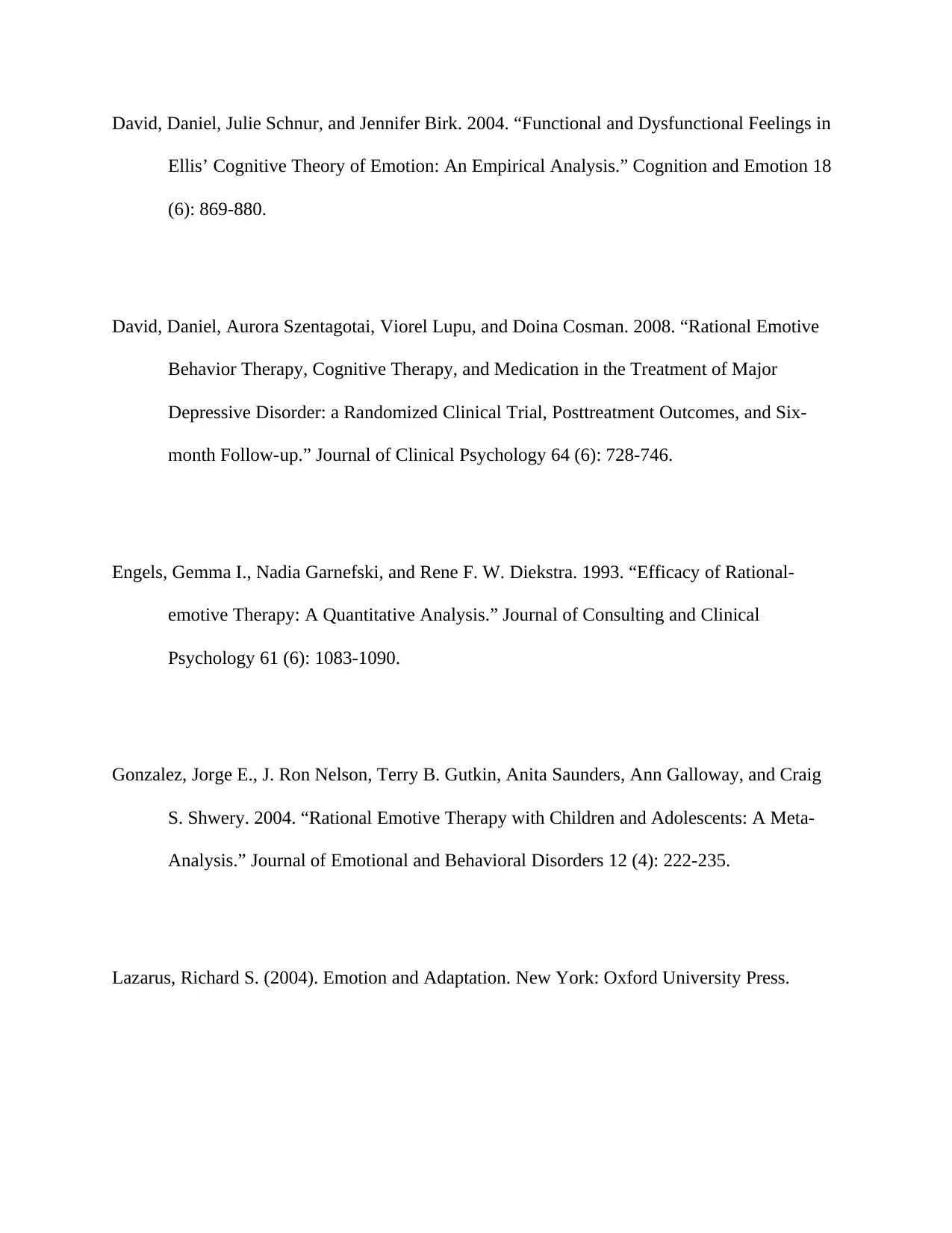
David, Daniel, Julie Schnur, and Jennifer Birk. 2004. “Functional and Dysfunctional Feelings in
Ellis’ Cognitive Theory of Emotion: An Empirical Analysis.” Cognition and Emotion 18
(6): 869-880.
David, Daniel, Aurora Szentagotai, Viorel Lupu, and Doina Cosman. 2008. “Rational Emotive
Behavior Therapy, Cognitive Therapy, and Medication in the Treatment of Major
Depressive Disorder: a Randomized Clinical Trial, Posttreatment Outcomes, and Six-
month Follow-up.” Journal of Clinical Psychology 64 (6): 728-746.
Engels, Gemma I., Nadia Garnefski, and Rene F. W. Diekstra. 1993. “Efficacy of Rational-
emotive Therapy: A Quantitative Analysis.” Journal of Consulting and Clinical
Psychology 61 (6): 1083-1090.
Gonzalez, Jorge E., J. Ron Nelson, Terry B. Gutkin, Anita Saunders, Ann Galloway, and Craig
S. Shwery. 2004. “Rational Emotive Therapy with Children and Adolescents: A Meta-
Analysis.” Journal of Emotional and Behavioral Disorders 12 (4): 222-235.
Lazarus, Richard S. (2004). Emotion and Adaptation. New York: Oxford University Press.
Ellis’ Cognitive Theory of Emotion: An Empirical Analysis.” Cognition and Emotion 18
(6): 869-880.
David, Daniel, Aurora Szentagotai, Viorel Lupu, and Doina Cosman. 2008. “Rational Emotive
Behavior Therapy, Cognitive Therapy, and Medication in the Treatment of Major
Depressive Disorder: a Randomized Clinical Trial, Posttreatment Outcomes, and Six-
month Follow-up.” Journal of Clinical Psychology 64 (6): 728-746.
Engels, Gemma I., Nadia Garnefski, and Rene F. W. Diekstra. 1993. “Efficacy of Rational-
emotive Therapy: A Quantitative Analysis.” Journal of Consulting and Clinical
Psychology 61 (6): 1083-1090.
Gonzalez, Jorge E., J. Ron Nelson, Terry B. Gutkin, Anita Saunders, Ann Galloway, and Craig
S. Shwery. 2004. “Rational Emotive Therapy with Children and Adolescents: A Meta-
Analysis.” Journal of Emotional and Behavioral Disorders 12 (4): 222-235.
Lazarus, Richard S. (2004). Emotion and Adaptation. New York: Oxford University Press.
⊘ This is a preview!⊘
Do you want full access?
Subscribe today to unlock all pages.

Trusted by 1+ million students worldwide
1 out of 14
Related Documents
Your All-in-One AI-Powered Toolkit for Academic Success.
+13062052269
info@desklib.com
Available 24*7 on WhatsApp / Email
![[object Object]](/_next/static/media/star-bottom.7253800d.svg)
Unlock your academic potential
Copyright © 2020–2025 A2Z Services. All Rights Reserved. Developed and managed by ZUCOL.




